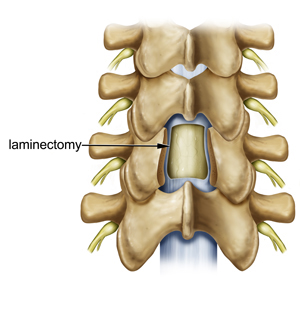
Understanding Laminectomy
In a laminectomy, your surgeon removes part of your vertebra, known as the lamina. The technique involves:
- Pushing back muscles aside, not cutting them
- Preserving the surrounding vertebral structures
- Typically, recovery spans a few days
Understanding Laminotomy
Addressing Spinal Narrowing
A laminotomy is a precise surgical procedure conducted to enlarge the canal that houses your spinal cord. By carefully cutting into the lamina—a key component of your spine's anatomy—the operation is aimed at alleviating the pressure on your nerves, often due to the canal's constriction.
- Purpose: To create more space within the spinal canal, relieving nerve or spinal cord compression.
- Process: A targeted portion of the lamina is reshaped, rather than completely removed to enlarge the canal opening.
Targeting Spinal Stenosis
Spinal stenosis, a primary reason for undergoing spine surgery, is effectively managed with this surgery. When the spinal canal narrows, causing nerve compression, a laminotomy may be part of the surgical strategy to offer you relief.
- Diagnosis: Spinal stenosis often leads to the need for surgical intervention.
- Solution: By adjusting the lamina, a laminotomy increases spinal canal space, thus helping to address nerve compression associated with severe spinal stenosis.
Frequently Asked Questions
Comparing Laminectomy, Laminotomy, and Laminoplasty
A laminectomy is a procedure where a portion of the vertebral bone called the lamina is completely removed. A laminotomy involves the removal of only a segment of the lamina, whereas a laminoplasty involves cutting the lamina to create a hinge, which is then propped open to enlarge the spinal canal.
Possible Risks from Laminectomy Surgery
The potential complications after a laminectomy might include infection, nerve damage, spinal fluid leakage, or blood clots. Pain at the site of incision and a possible reaction to anesthesia are also risks to consider.
Foraminotomy vs. Laminotomy: Surgical Differences
A foraminotomy involves widening the opening where nerve roots exit the spine, known as foramen, while a laminotomy entails removing a section of the lamina. The goal of a foraminotomy is mainly decompressing nerve roots, and a laminotomy aims to relieve pressure on the spinal cord or nerves by removing part of the lamina.
Hemilaminectomy vs. Laminotomy Explained
A hemilaminectomy involves removing one side of the lamina, typically performed to treat unilateral spinal conditions. In contrast, a laminotomy involves the removal of a small portion of the lamina from both sides if needed.
Recovery Expectations for Laminectomy and Laminotomy
Post-surgery, the recovery period can vary. Patients may experience pain at the incision site and are typically advised to avoid strenuous activities. Physical therapy may be recommended. Recovery time may be shorter for laminotomy since it's usually less invasive than a laminectomy.
Success Rates for Cervical vs. Lumbar Laminotomy
The success of a laminotomy can depend on various factors, including the location of the procedure. Cervical laminotomies involve the neck region, while lumbar laminotomies are conducted on the lower back. Success rates for both procedures generally reflect positive outcomes, but individual conditions and surgeon experience can influence results.